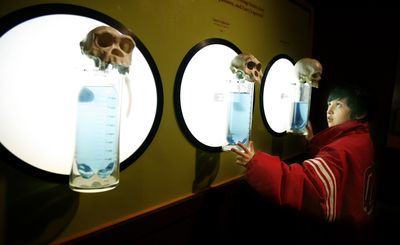A date with pre-history
Moses Lake grade-school students raise money to see Lucy exhibit

SEATTLE – When the gang of sixth-graders in Kelly Frederick’s class at Chief Moses Middle School heard that Lucy was not doing well, they decided to raise a fuss and do something about it.
Lucy, the 3.2-million-year-old fossil remains of an ancient ancestor to modern humanity, was not doing well in terms of expected turnout at the Pacific Science Center. Despite being one of the most important finds in the study of human evolution, the $2.25 million exhibit “Lucy’s Legacy” has drawn perhaps less than half the number of visitors the center had needed, something like 250,000, to simply break even. The exhibit closes March 8.
A news story went out in the media about how nobody was coming to see Lucy, about big losses and layoffs at the center. So when sixth-graders Alex Naccarato and Mercedez Cloninger heard about this, they and their classmates decided to raise some money of their own.
“We had been studying Lucy in class,” Alex said. They were surprised to learn the famous fossil was so close, and that this could be the last chance for anyone in the U.S. to see the discovery.
Alex and Mercedez’s pitch to their local paper got a story written about the students’ desire to see Lucy and ended up raising enough money – $1,600 – from parents and other donors to cover the costs for a visit.
“We got money even from people who said they disagreed that Lucy is related to humans,” Frederick said. “Everyone just wanted to support the students’ interest in this.”
So on Wednesday morning, two Moses Lake School District buses pulled up at the Denny Street entrance to the Pacific Science Center and disgorged 70-plus enthusiastic middle school students bent on taking advantage of the chance to see this ancient precursor to humankind.
“It’s pretty cool to get to really see her,” said Mercedez, standing next to the glass box containing the bones. “She walked on two legs like us.”
Classmate Hayden Martz examined several side exhibits illustrating the anatomical differences and similarities among chimpanzees, Lucy (a proto-human species technically known as Australopithicus afarensis ) and modern humans. Hayden was dubious about the notion that we shared a common ancestor.
“I think it’s still a mystery,” he said.
Sixth-grader Michael Goss, however, didn’t need any convincing.
“Is it because of her bones that they could tell she was our relative?” Michael asked curator Diana Johns. Yes, Johns said, pointing out to a rapt audience of 11- and 12-year-olds some features about the hip and leg bones that scientists say are clear links to modern humans.
“This is apparently the last time anyone is going to see her in the states,” said Donald Johanson, the American paleoanthropologist at Arizona State University who, with his colleagues, discovered the fossil in 1974 in northern Ethiopia. “It can be a very emotional experience. I’m glad these kids understood what a great opportunity this was and took the initiative upon themselves to come see her.”